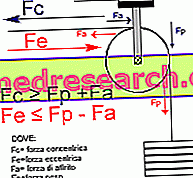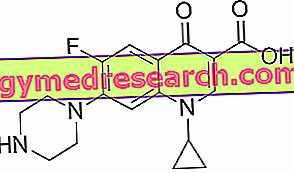Before listing the advantages and disadvantages of the two training methods, let's step back and analyze the issue physically.
 | Assuming a muscular exercise on a machine equipped with a pulley: during the concentric phase Fc (muscle contraction) the friction force is added to the weight force, increasing the machine's resistance to movement. during the eccentric phase Fe (muscular lengthening) the friction force subtracts itself from the weight force reducing the resistance of the machine to the movement. |
During the eccentric phase, the overall load decreases because, by definition, the friction force always has the direction of speed and is opposite to it.
Being the eccentric contraction more important for the muscular development than the concentric one, decreasing the load in this phase will also decrease the stimulation of the affected muscles.
However this is neither the only nor the most important reason why free weights are more effective for developing muscle mass.
This table shows the major advantages and disadvantages of using the two different training methods.
FREE WEIGHTS | CARS |
| Low cost and easy retrieval | High cost and bulk |
| They are versatile because they can be adapted to more exercises | They allow one or a limited number of exercises to be performed |
| They involve both concentric and eccentric muscle activity | Some hydraulic and isokinetic machines significantly reduce eccentric muscular activity |
| They require greater coordination of movement (they are controlled on all the dimensions of space | They require less coordination of movement (generally they are controlled on a single plane of movement |
| They cause a greater pressure rise and require the learning of a correct breathing technique | They cause a lower pressure rise that must be controlled using a correct breathing technique |
| They are unlikely to isolate the individual movement or muscle group | They isolate a movement or a muscle group |
| They also train the movement stabilizing muscles, by static contraction | They train fewer stabilizing muscles. |
| Learning the correct execution technique takes longer | Learning the correct execution technique requires less time |
| Increased risk of accidents | Lower risk of accidents |
| They do not need external adjustments | They need external adjustment, moreover children, very tall or very low subjects might not find the right adjustment |
| They allow physiologically more correct trajectories | Very often they force forced trajectories that are not physiologically correct |
They allow to work with the desired percentage of load only in the short section of the joint movement where the body segment has the maximum lever arm (moment).  | Allow the muscle to develop a constant tension (load) and executive speed throughout the joint excursion (cam machines)  |
| They educate proprioception and improve motor coordination | They do not educate proprioception and motor coordination |
| Induce more stress on the spine | Induce less stress on the spine (if constructed properly) |
| Induce greater hormonal response (GH and testosterone) | Induce less hormonal response |



